From museum gardener, seeds of change
April 4, 2013
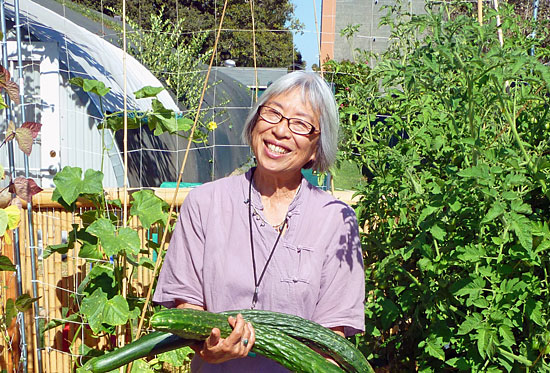
Florence Nishida's Natural History Museum class has sprouted gardens all over L.A. Photo/Gordon Hendler
For some, spring is a chance to plant a few tomatoes. For Florence Nishida, it’s an opportunity to re-landscape the face of Greater L.A.
This month, for example, the 75-year-old master gardener will be checking in on some of the 20 or so South Los Angeles yards she helped turn into vegetable gardens. She’ll be sizing up a front lawn and a parkway for makeovers by Los Angeles Green Grounds, the urban gardening group she co-founded.
She’ll be monitoring the community garden she recently did in Koreatown for the new First 5 initiative, Little Green Fingers, and following up with the Los Angeles Conservation Corps on the raised beds she devised for outside their East L.A. office. Then there’s the LA Green Grounds table to set up and man for Earth Day at the Natural History Museum of Los Angeles County, not to mention the regular Sunday gardening workshops she conducts at the museum.
And this is the former schoolteacher’s idea of retirement.
“From years and years ago, it has been my goal,” explains Nishida, “to have a vegetable garden and a fruit tree on every block in L.A.”
Nishida isn’t the only urban gardener on a mission these days in Los Angeles County, but lately, she has been among the more productive ones. Since 2010, when she persuaded the Natural History Museum to let her install a small teaching garden on its Exposition Park campus as part of an inner-city community project, her green thumb has been in many, if not most, of the urban gardening projects that have sprouted across the city like backyard zucchini.
One of her first students, artist Ron Finley, has won international acclaim with a pair of TED talks on urban gardening. Her former teaching assistant, the museum’s public programs manager Vanessa Vobis, is among at least five protégés who have gone on to become fellow master gardeners. Green Grounds, which she co-founded with Finley and Vobis, has literally broken new ground in South L.A., where the group has worked one yard at a time, installing gardens at volunteer “dig-ins” to help under-served neighborhoods grow their own organic produce.
Nishida herself has been called in increasingly to consult on community gardening projects throughout the county. Meanwhile, her edible garden at the Natural History Museum has drawn some 150 students just to the beginner’s workshop; this year, her class will expand to the new Erika J. Glazer Family Edible Garden, a showplace of fruit trees and seasonal plantings that will open officially in June with the rest of the museum’s new Nature Gardens.
“The museum was ground zero,” Nishida says now. “It all started from that class.”
Nishida hasn’t always seen gardening as a road to anyone’s revolution. A native Angeleno, she says, home gardens were a fact of life for her Japanese-American relatives throughout Southern California and in the Exposition Park neighborhood where she grew up.
“After World War II, my grandparents resettled in West L.A. near Sawtelle and grew vegetables in their front yard, as did a lot of people,” she remembers. But as time passed and L.A.’s economy shifted, fast food joints, un-walkable streets and dense apartments crowded out the kitchen gardens and mom-and-pop produce stands, gradually eroding the city’s health and turning organic produce into an upper-middle-class status symbol.
As Nishida moved to Topanga, worked and raised her four children, she says, she always held a notion that her old, blighted neighborhood might be restored if someone could bring back the green space. Eventually—after 20 years as an English teacher in the Los Angeles Unified School District, another 20 as a bureau manager and research librarian at People magazine’s West Coast Bureau and a graduate degree in botany that resulted in a sideline as a mushroom expert at the Natural History Museum—she decided to revisit her old theory.
“I had seen a little article in the Los Angeles Times about the master gardening program at the UC Cooperative Extension,” she remembers. “It was a tiny little article, but for whatever reason, I just saved it.” When she retired in 2008, she says, she took the classes, which require, among other things, that graduates go on to lead community gardening projects in under-served parts of their cities; one of her early projects was a home garden that later served as a model for Green Grounds. Another was a plan to bring gardening knowledge to Exposition Park by launching a class at the museum.
That idea—which dovetailed with the museum’s centennial plans to re-landscape its North Campus into a “living laboratory”—led to her meeting with Finley, an experienced gardener in his own right who had signed up for her class after he had noticed another master gardener’s project near Dorsey High School. Soon Nishida was asking Finley for advice on how to bring more neighborhood people into her museum classes.
“I told her, ‘They’re not gonna come to your classes—they got Burger King, they got Kentucky Fried Chicken’,” recalls Finley. “We gotta take it to them.” That, he says, was the start of Green Grounds, which effectively installs free gardens in people’s front yards in the style of an old-fashioned barn raising, and which has taken off since Finley’s second TED talk in February.
“We got people driving in from Ventura,” he marvels. “I’m like, damn! Is it that boring in Ventura? I mean, we had over 300 people sign up at our last dig-in, and all we needed was 15.”
Nishida says Green Grounds has been an education, not only in the art of managing volunteerism but on the laws of nature in L.A. Their first garden flourished for three months, only to be destroyed by the homeowner’s German shepherd. Another garden fed a family for nearly half a year before they were evicted. A third fell prey to a local gang she’d never heard of—gophers. Finley famously fought with the City of L.A. over the parkway he wanted to replant outside his house.
Nonetheless, Nishida says, 13 of the Green Grounds gardens are still blooming, with more in the pipeline; recently the group set up a fiscal sponsorship with the L.A. Community Garden Council to handle the influx of donations since Finley’s TED talks. And those gardens have, in turn, been change agents: Neighbors have gotten to know each other over samples of fresh produce, she says, and exercise groups have sprung up among dig-in volunteers and recipients of gardens.
In fact, she says, her only disappointments have been that the movement hasn’t spread faster, and that her commitments have left her so little time to tend to her own yard.
“Oh, it’s awful,” she confesses, laughing. “My vegetable beds are overrun with weeds.”
Posted 4/4/13
Making new connections in the Valley
March 14, 2013
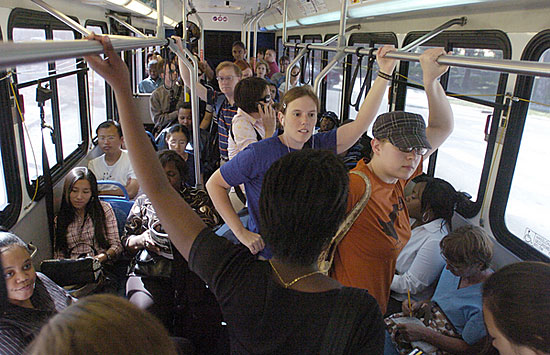
There’s a new ride coming to the Valley—either a light rail or rapid busway. Now’s your chance to weigh in.
First came the Orange Line, a dedicated busway in the San Fernando Valley that gives folks from Woodland Hills to North Hollywood a speedy alternative to local bus lines or traffic on the 101. Ridership on the line continues to surge, and an extension to Chatsworth opened last June.
Now the focus shifts eastward. The East San Fernando Valley Corridor project, to be routed along Van Nuys Boulevard and San Fernando Road, is about to enter its environmental review phase.
“The Van Nuys corridor is the most heavily traveled north-south route in the San Fernando Valley, with about 25,000 boardings per day,” said Walt Davis, manager of the Metro project. “There is a need for a premium service to serve those people.”
During the environmental review phase, plans for the project will be studied in greater detail and refined. This Saturday, Metro will hold the first of four meetings to present the options as they now stand, and take feedback and comments.
“It’s a chance to better define the scope of what we’ll be looking at and for the public to tell us what their concerns and needs are,” Davis said.
Two alternatives will be studied. One is a light rail option and the other is a bus rapid transit line similar to the Orange Line. Either choice would go along Van Nuys Boulevard and San Fernando Road between Ventura Boulevard and the Sylmar/San Fernando Metrolink station. (Click here for a map of the light rail alternative and here for a map of the rapid bus alternative, which includes several sub-options south of the Orange Line). The line is scheduled to begin operating in 2018.
The rail alternative is projected to generate more riders, and it also comes with a higher price tag, somewhere between $1.8 billion and $2.3 billion. The rapid bus option is projected to cost between $250 million to $500 million. Currently, only about $170 million is dedicated to the project, so more funding would need to be lined up in either case.
In addition to serving immediate neighborhoods, which include shopping centers, schools, health care facilities and civic centers, the line will provide a fast link to other transit options. It will connect to Metrolink stations in Van Nuys and San Fernando as well as to the Orange Line, which in turn links to the Red Line and the rest of the Metro rail system. The south terminus of the line will be designed to connect to a future line between the Valley and the Westside that is under study.
The public meetings will take place at the following times and locations:
- Saturday, March 16, 10 a.m. to 12 p.m. at Panorama High School, 8015 Van Nuys Boulevard
- Tuesday, March 19, 6 p.m. to 8 p.m. at the City of San Fernando Regional Pool Facility, 208 Park Avenue
- Thursday, March 21, 6 p.m. to 8 p.m. at Arleta High School, 14200 Van Nuys Boulevard
- Wednesday, March 27, 4 p.m. to 6 p.m. at Marvin Braude Constituent Service Center, 6262 Van Nuys Boulevard
In addition to the meetings, Metro for the first time will accept formal comments on social media. Go to the project’s Facebook page and click on “Submit Scoping Comments” or tweet to @EastSFVTransit using the hashtag #ESFVScoping to take advantage of this option. Formal comments may also be mailed to Metro or submitted by email to [email protected].
Posted 3/14/13
Expo 2’s ahead of the curve
February 7, 2013
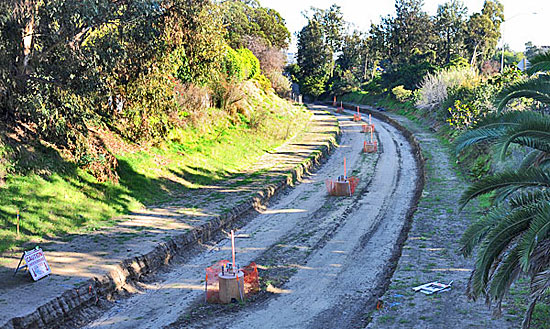
The Northvale Trench in Cheviot Hills, where Expo trains will run along a path blazed by their rail predecessors.
Maps and blueprints are fine, but there’s nothing like getting out into the real world and seeing the future take shape.
A few days ago, I had the opportunity to tour the second phase of the Expo Line, which is rapidly taking form along a corridor running from Culver City to Santa Monica.
It was remarkable. New bridges are rising, a once-abandoned railroad right-of-way is coming back to life and the contours of the project are emerging before our eyes.
The thrill of going behind the scenes in the construction zone was kind of like seeing a prenatal sonogram: Expo Phase 2 is still a long way from the delivery room, but this baby’s shaping up beautifully.
When the 6.6 mile stretch is finished in 2015—with a final station just a short walk from the Pacific Ocean—it will complete the light rail line that’s now carrying more than 23,000 passengers a day between downtown Los Angeles and Culver City. It will offer a true alternative to the heavily congested Santa Monica Freeway that it parallels for much of its route.
And it will mark another crowning achievement in what I consider the golden era of public transportation infrastructure development in the Los Angeles region.
Think about it: in just the last 10 to 15 years, we’ve built a subway to the San Fernando Valley, forged light rail connections to Pasadena, East Los Angeles and Culver City, and created two legs of the Orange Line rapid transit busway that now runs from North Hollywood to Chatsworth. Workers currently are constructing a new stretch of the Gold Line from Pasadena to Azusa, and work should be starting on the Crenshaw Line to LAX in the not-too-distant future. We’re also preparing to extend the subway to the Westwood V.A. and to build a Regional Connector downtown to help tie it all together.
As we’ve grown the system, the whole has proven to be much bigger than the sum of its parts, offering a bustling network of region-wide connections that would have been unthinkable a generation ago.
In our notoriously sprawling and supposedly car-dependent region, we’ve shown that Angelenos aren’t wedded to their automobiles and in fact are more than willing to vote with their feet if we can offer alternatives to an increasingly clogged freeway system.
I fully expect them to beat a path to the Expo Line when it’s complete. I’m not just talking about folks who live on the Westside but also the thousands throughout the region who commute there for jobs and recreation.
From what I saw during my tour, it’s clear that this line will offer them more than just a great escape from traffic on the 10. It also will provide a bargain tour of Los Angeles rarely glimpsed through the windshield of a car. It includes a sylvan stretch in Cheviot Hills where the Red Car once ran, panoramic views from bridges and elevated platforms along the route, and a middle-of-the-street trip through the pleasant urbanscape of Colorado Boulevard before it concludes at 4th Street and Colorado, just across from Santa Monica Place and down the street from the Pier.
Construction projects, of course, are highly unpredictable but I’m happy to report that this one, for now, is on time and on budget—maybe even a little ahead of the game.
But we can’t afford to let up.
Funding for Expo Phase 2 and other projects comes from Measure R, the ½-cent sales approved by 68% of county voters in 2008. Disappointingly, efforts to extend the sales tax for another 30 years—making it possible to get moving sooner on an array of transportation projects—failed at the ballot box this past November.
The extension, known as Measure J, lost even though it received 66.11% of the vote because of an anachronistic provision in our state constitution requiring two-thirds voter approval for such measures.
This needs to change.
So as construction teams work to finish Expo, efforts are building in Sacramento to try to move the approval threshold from two-thirds to a still-difficult but more reasonable 55%.
I hope that the state’s voters are ready for the change, and for the improvements in transportation infrastructure it could generate.
Because here in Los Angeles, we’re building a transit system that will benefit our region for generations. And we have no intention of turning this train around now.
Posted 2/7/13
Westward ho for CicLAvia
January 17, 2013
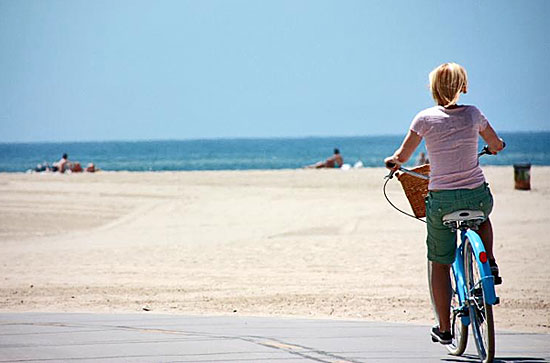
Manifest destiny: CicLAvia's getting ready to roll all the way to the coast. Photo/planetc1 via Flickr
Saddle up, Westsiders: L.A.’s favorite rolling street party is headed your way in April.
CicLAvia, the car-free bicycle and pedestrian fest started in 2010, is on the move again, preparing for its most ambitious year yet with three events, including one that will stretch from downtown to Venice Beach on April 21.
It’s part of a major expansion that organizers hope eventually will stretch to all corners of the county and create 12 separate, localized CicLAvias each year.
“Up till now we’ve been downtown. Now we want to show that it will work in the rest of the region,” said Aaron Paley, CicLAvia’s co-founder. A second 2013 CicLAvia is being planned for June 23 with a new route expected to run along Wilshire Boulevard from downtown L.A. to Fairfax Avenue near LACMA. And this year’s third event, on October 6, will return to familiar territory downtown, although with a deeper stretch into Boyle Heights and a new route into Chinatown.
The downtown-to-Venice Beach route will be the longest yet for CicLAvia—15 ¼ miles each way—and carries with it some important cross-town symbolism.
“One of the things that’s exciting about connecting downtown and the Pacific is just the sheer drama and the significance of it,” Paley said. “We know that the east-west connection is very difficult and for people who drive it every day, it’s a challenge…The idea that you will be able to walk or ride your bike—or go in your wheelchair or do your inline skating—and go from downtown to the beach is just of historic significance.”
Venturing out on such a long ride should be attractive to many participants, but Paley said the event is more about creating a pop-up “linear park” on city streets than throwing down an endurance challenge.
“This isn’t the marathon. It isn’t all or nothing,” he said. “We want kids to be able to explore, maybe get out and ride in the streets for the first time that day. And if they ride a half mile, that’s great.”
The hope is that participants will arrive via public transportation if possible—perhaps by taking the Expo Line to the Culver City station at Venice and Robertson, or riding the bus to the Pico/Rimpau Transit Center at Venice and San Vicente.
Paley said the impetus for pushing outside the downtown zone and toward the ocean this year came from Los Angeles Mayor Antonio Villaraigosa, who kept asking: “When can we go all the way to the beach?”
The mayor, he said, even burst into a planning meeting to promote the idea—prompting a round of brainstorming in which the Department of Transportation’s special events traffic guru, Aram Sahakian, came up with the idea of using Venice Boulevard, a route traveled by other events like the Los Angeles triathlon.
“We’ve used it before. We know exactly what we’re dealing with,” Sahakian said.
Taking the route deep into the Westside—where traffic woes are among the city’s worst—will require plenty of outreach to make sure residents and businesses know what’s coming. “I’m crossing my fingers and praying that they won’t be too unhappy,” Sahakian said.
So far, so good, said Diana Rodgers, who manages the Mar Vista Farmers’ Market and is enthusiastic about the coming of CicLAvia to her area.
“We love it and we want to be a partner and provide refreshments,” she said.
The farmers’ market, which takes place on Sundays and is located on Venice at Grand View Boulevard, is accustomed to rolling with the closures that come with big events like the marathon and triathlon, Rodgers said, and should be able to take CicLAvia in stride.
“As long as we have the information, we tend to do OK, as long as we have crossing guards at the points needed,” Rodgers said.
Westside cyclists like Cynthia Rose, director of the group Santa Monica Spoke, said the new route will be a big draw in her part of town.
“There’s a huge pool of enthusiastic Westside supporters and they’ve felt sort of geographically separated,” she said. “Now all of a sudden it’s going to be that connecting of the dots, from the ocean to downtown Los Angeles.”
Paley said the final map for the downtown-to-Venice Beach route is still being fine-tuned. The CicLAvia team will be taking an exploratory ride along the proposed route Sunday to see how it works and connects with two major hubs downtown—City Hall and Union Station.
Beyond the 2013 lineup, he’s looking forward to CicLAvia’s gradual multi-year expansion.
“We want the entire county to be able to benefit from Ciclavia,” Paley said.
So what’s on tap for 2014? “I can tell you that the Valley,” Paley said, “is high on our list.”
Posted 1/17/13
The chair recognizes…
December 6, 2012
With my final term as chairman of the Los Angeles County Board of Supervisors ending this week, I’ve been reflecting on some of the challenges—and accomplishments—of the past year. I know there’s no shortage of tough issues ahead. But it’s healthy, I think, to take stock of our progress, too.
For starters, the Board of Supervisors this year aggressively moved to fix the seemingly intractable problems in the Department of Children and Family Services. Earlier, last February, amid an uproar over a number of high-profile child deaths and questions about the department’s forthrightness, we named Philip Browning as DCFS’s new director. By all accounts, he has brought a new level of accountability and creativity to the department.
At the same time, the board set the stage for major changes in First 5 L.A., the organization responsible for making sure that voter-approved tobacco tax revenues are being effectively spent on improving the lives of our children from birth to 5 years old. We’ve brought in a new executive director, Kim Belshé—former head of the state Health and Human Services Agency—who’ll ensure that unspent surpluses will no longer build in the group’s bank accounts while youngsters are in need.
We also confronted another problem that was eroding public confidence in the integrity of our local government—brutality by sheriff’s deputies assigned to the Los Angeles County jail system. Late last year, the board created the blue-ribbon Citizens’ Commission on Jail Violence with a mandate to pull no punches in assessing responsibility for the violence and in offering ways to bring it under control.
This September, the panel returned with a verdict, placing blame for these unacceptable breaches of public trust at the highest levels of the department and recommending more than 60 reforms, which are now being implemented. This week, we appointed the commission’s general counsel, Richard Drooyan, to oversee this effort.
On another front, this year marked a watershed in the county’s battle against chronic homelessness.
As perhaps many of you know, I’ve championed a program called Project 50, aimed at providing permanent supportive housing to those most likely to die on the streets of Skid Row. This highly successful effort, which has been replicated throughout my district, served as the foundation for the creation of the Los Angeles County Interdepartmental Council on Homelessness. Last month, the council adopted our first-ever blueprint of how to attack this problem in every corner of the county. Although funding will continue to be an issue, we’ve coordinated the resources and expertise of numerous county agencies that for too long were chipping away alone at this vexing human tragedy.
Transportation continues to be a preeminent issue in our region, and this year we marked a couple of milestones. The first leg of the Expo Line opened in April, bringing rapid mass transit to the Westside for the first time since the Red Car. It’s now attracting record numbers of riders and work on the second and final leg is now well underway to extend the line to Santa Monica. And in the San Fernando Valley, a new four-mile northward extension of the Orange Line opened between Warner Center and Chatsworth in June—giving riders of the popular rapid transit busway even more options and connection possibilities.
We also, at long last, righted some wrongs this year.
In a long overdue move, the board rescinded a World War II-era county resolution urging the forced relocation of Japanese American families to internment camps. “It’s never too late to do the right thing,” said my colleague, Mark Ridley-Thomas, the board’s incoming chairman, who authored the motion. I certainly agree, and I continue to hear from members of the Japanese American community about how meaningful this was to them. The board, at the recommendation of Supervisor Gloria Molina, also issued a formal apology over the so-called “repatriation” of people of Mexican ancestry during the Great Depression, another stain on L.A. County’s history. By recognizing and acknowledging these violations of human rights, we can, I hope, reduce the likelihood of repeating them in the future.
Finally, we continued to recognize and support the arts as a life-enhancing and economically vital part of Los Angeles County life—from the smallest organizations bringing dance, music or visual arts to children to glamorous, internationally recognized players like the Los Angeles Philharmonic and LA Opera, and venues like the Hollywood Bowl, the Natural History Museum and the Los Angeles County Museum of Art.
As Supervisor Ridley-Thomas assumes the chairmanship, I wish him and all my board colleagues a productive and fulfilling year. Together, I believe we can make 2013 an even better year in service of all the people of Los Angeles County.
Posted 12/6/12
After turkey, taste L.A.’s latest
November 19, 2012
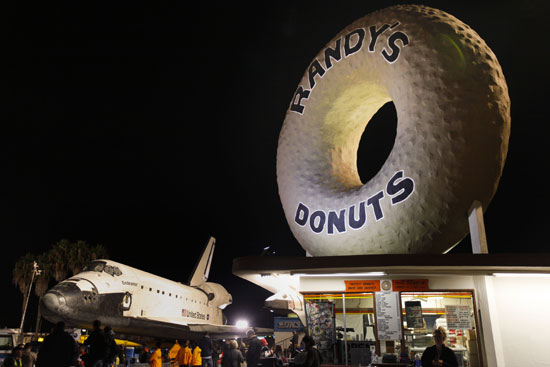
Two L.A. icons passed in the night, as the space shuttle Endeavor made its way to the California Science Center.
Once Thanksgiving dinner has been eaten, the leftovers packaged and all the tryptophan-induced post-dinner naps taken, you’ll realize there are still three days of holiday weekend left on your plate. Whether you’re hosting out-of-towners or just looking to explore, it’s the perfect time to see what’s new around town. Some pretty big things have been happening in Los Angeles County this year. Let’s start with a space shuttle:
Endeavour to the California Science Center
This one’s so huge it had to be flown in piggyback-style on a specially designed NASA aircraft. The decommissioned space shuttle Endeavour reached to its final resting place at California Science Center on October 14, where it is now on display. If you go to see it, you should also catch Cleopatra: The Exhibit, which features the largest collection of Cleopatra-era Egyptian artifacts ever displayed in the United States. It wraps up its 7-month stint at the center on December 31.
All aboard Expo
You can get to the Science Center by taking advantage of another L.A. newcomer—Metro’s Expo Line, the first modern passenger rail line to connect downtown and the Westside. (The line currently extends to Culver City. Phase 2 of the line, slated for completion in 2016, will extend all the way to Santa Monica.)
In addition to the Science Center, the line serves major landmarks like the Staples Center, the L.A. Coliseum, ExpositionPark and Natural History Museum. There are plenty of homegrown culinary destinations, too, if you want to add some variety to the regimen of Thanksgiving leftovers. See Metro’s handy list for other destinations and attractions.
“The Rock” and more at LACMA
Michael Heizer’s “Levitated Mass” art installation was the talk of the town this past summer before it was even installed. Its centerpiece 340-ton boulder drew crowds of onlookers as it inched its way through the streets towards the Los Angeles County Museum of Art. It took a herculean effort to get it there—it’s not going anywhere fast. While you’re there, you can check out two exhibits that won’t be around forever—one on Robert Mapplethorpe’s photography and another featuring the art of director Stanley Kubrick.
A day in the park
It’s been a good year for parks, so there’s more reason than ever this year to get out and exercise the gravy out of your system. Grand Park made its debut in October, giving Angelenos a new place to relax and play outside. Go for a stroll, experience the diverse programing presented there or kick back and watch the remodeled fountain from one of the park’s striking, movable hot pink seats.
Elsewhere, the Santa Monica Mountains wilderness area got a new visitors center at King Gillette Ranch, while El Cariso Park in Sylmar just opened a community center and gymnasium.
Blazing new paths
Parks aren’t the only places to burn calories. When Metro’s Orange Line Extension to Chatsworth opened in June, four miles of bike path opened with it, giving a big boost to local bike infrastructure and drawing cheers from L.A.’s fast-growing cycle culture. More bikeway was added along the L.A. River this year, too, and passage of the county Bicycle Master Plan means the region will be getting more bike-friendly in the future. For walkers, there’s a new section of greenway to explore in the San Fernando Valley.
The Science Center, LACMA and the Natural History Museum are all closed on Thanksgiving Day, November 22, but will be open during normal hours for the rest of the weekend.
By getting out and staying active this Thanksgiving weekend, you can help make sure the next “big thing” in L.A. isn’t you.
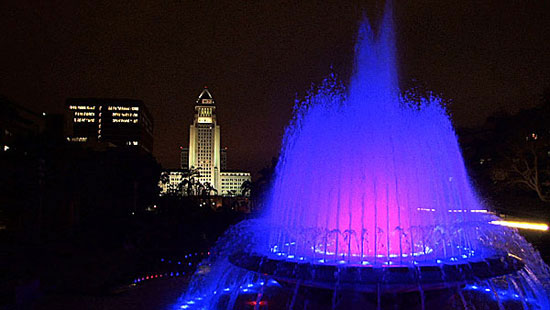
The Arthur J. Will Memorial Fountain was restored, lit and enhanced as part of downtown's new Grand Park.
Posted 11/19/12
A giant step for L.A.
November 18, 2012
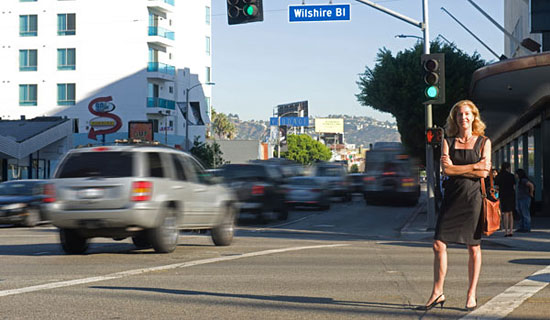
Margot Ocañas, the city’s new pedestrian coordinator, at the intersection of Wilshire and Fairfax this week.
In some ways, Margot Ocañas has been walking the walk ever since she was a kid growing up in Lancaster, Pennsylvania, and her mom sent her off to modern dance lessons with the words:
“You’ve got two feet and a bicycle. Get going.”
Talk about prophetic. Today, Ocañas—a Mandarin-speaking Fulbright scholar and one-time Wall Street analyst whose resume also includes running an independent film company with her husband and developing “streets for people” projects at the county Department of Public Health—is jumping feet first into a brand new role with major ramifications for how L.A. moves into the future.
As Los Angeles’ first pedestrian coordinator, Ocañas, 48, is front-and-center of a growing movement that aims to rethink streets as we know them.
Her appointment is just the latest sign—along with car-free CicLAvia events, a new pedestrian plaza in Silver Lake and a burgeoning public transit system—of how Los Angeles is throwing off its car-centric reputation in sometimes unexpected ways.
“The national momentum is very much our friend right now,” Ocañas said. Pedestrian awareness is “part of a larger national conversation. People are in tune with that.”
Ocañas and assistant pedestrian coordinator Valerie Watson, an urban and regional planner by training, have recently joined the city Department of Transportation. Their mission: making life better for walkers on streets that often were built mostly to enable automobiles to get from Point A to Point B as efficiently as possible. The tools of transformation include reshaping lanes and crosswalks, changing signs and signals—anything to foster calmer corridors and reduce the “raceway mentality” that’s rampant on many streets.
And then there are those things that are beyond the DOT’s purview—such as “street furniture” like benches and light fixtures. “To enhance the safety and the warmness of a corridor, you might want to start installing more of what I call human scale lighting. You may have flower baskets, or trash cans,” she said. “I think it’s those types of amenities that just make it feel more like an outdoor living room.”
Since sidewalks and street furniture fall under the Bureau of Street Services, not the DOT, part of her job involves reaching across departmental lines. “There are just increasingly strong strategic working relationships and partnering that’s happening with Street Services and Street Lighting,” she said.
Deborah Murphy, founder of the pedestrian advocacy group Los Angeles Walks and chair of the city’s Pedestrian Advisory Committee, said she’s been urging the appointment of an L.A. pedestrian coordinator for more than 15 years. While Los Angeles still has a long way to go to before it catches up with other cities including, locally, Santa Monica, she senses a permanent transformation is underway.
“I have really seen a huge change in the last year,” she said. “I’m thrilled. I think Margot and Valerie bring lots of great energy to pedestrian safety, and to encouraging people to walk.”
The well-traveled Ocañas, who moved to Los Angeles in 2003 from New York by way of Austin, also thinks the moment is right for the city to get in touch with its pedestrian side. She’s reached out to counterparts who are on the same journey in New York, which is regarded as a national leader in reconfiguring streets, notably in Times Square, as well as in San Francisco and Chicago. She thinks it can’t hurt that stratospheric gas prices are making alternative modes of getting around look better and better these days.
“Selfishly, I’d love to see gas prices not go down,” said Ocañas, who gets to work by bike, bus and foot three days a week and has organized a “bike train” caravan to get her two children to school each morning. “I could be talking till I’m blue in the face but there are certain triggers that just force behavioral change.”
Walk a mile in her slingbacks, and you’ll quickly get a sidewalk-level view of what’s good, bad and ugly out there on the L.A. pavement.
At the busy triangular intersection where Fairfax, Olympic and San Vicente come together, Ocañas watched one morning this week as pedestrians scrambled to cross. She reflected on how broad streets with short signal times can pose difficulties, especially for the elderly.
“I have seen situations where seniors are caught three-quarters of the way across the street and the light has turned,” said Ocañas, who lives in the neighborhood with her family. “We do have a population that’s getting older. We need to adjust signaling to ensure their ability to cross more effectively.”
Beyond that, “unwelcoming” streetscapes can send a forbidding signal to just about anyone who’s not in a car.
“People are not incented, or motivated, or enthused at times to get out and walk,” she said. “But those times are changing.”
Her proposed solution: “Re-engineer the environment.”
Ocañas’ previous position as a policy analyst at the county Public Health department’s Project RENEW, funded with federal stimulus dollars, involved working on grant proposals intended to combat obesity by confronting challenges in L.A.’s “built environment”—such as those long, unshaded stretches of roadway where fast car traffic and widely separated crosswalks make it uninviting or impossible for pedestrians to stroll and interact.
“When I was on the health side, we always talked about, ‘We’ve built ourselves into sickness so we need to build ourselves out of sickness,’ ” Ocañas said. One of the projects she worked on turned into the green polka-dotted Sunset Plaza Triangle pedestrian zone in Silver Lake, which opened in May.
Her own transformation, from a career in the private sector that included working at Dell Computers, started modestly enough, with a block party closure she organized to give neighborhood kids a chance to wheel around freely on their bikes and scooters. Ryan Snyder of the urbanist transportation planning firm Ryan Snyder Associates was there as the guest of a neighbor. When he met Ocañas, he mentioned the upcoming policy analyst positions in Public Health.
A light bulb went on. “It never occurred to me to consider taking a recreational passion and translate it into a paying job,” she said.
At the city Department of Transportation, Ocanas’ and Watson’s first priority is developing a Safe Routes to School Strategic Plan for the city. The “data-driven” plan will help the department prioritize spending on student safety projects and will introduce “new types of pedestrian-centered amenities” into the mix. It also will serve as a building block for the eventual creation of a “Pedestrian Safety Action Plan” for Los Angeles—something that’s probably three to five years down the road.
At the same time, they’re working to foster innovative “place making,” including “parklets” (tiny curbside areas the size of parking space, often in front of businesses and furnished with seating areas and plants) as well as bike corrals and pedestrian plazas like the one in Silver Lake.
“You do these things that you can quickly implement with low-cost materials…to help demonstrate the benefits of ‘people-space,’ ” Watson said.
Ocañas, who like Watson is being paid by DOT Measure R funds that have been targeted for pedestrian initiatives, said she’s finding the department a “very supportive environment.”
“I actually find them very open,” she said. “We will debate. I will learn from them: ‘OK, you just can’t do that, and for these reasons.’ But similarly, they are very open to ‘Why not?’ ”
Posted 10/18/12
Expo work keeps on rolling
November 16, 2012
Construction on the second phase of the Expo Line will continue moving ahead while a legal appeal of the project’s environmental process is pending, the California Supreme Court ruled this week.
The homeowners group Neighbors for Smart Rail had asked the state’s high court to halt work on the light rail line until its appeal could be decided. The group’s lawsuit challenging the project’s environmental review previously has been rejected at both the state trial and appellate court levels.
The initial segment of the Expo Line is now running between downtown L.A. and Culver City and is attracting record numbers of riders. Construction on the $1.5 billion second phase of the line, which will run to Santa Monica, is now underway.
“This decision preserves thousands of direct and indirect jobs just when our local economy is slowly starting to recover,” said Supervisor Zev Yaroslavsky, who also serves as chairman of the Expo board. “At the same time, it keeps our efforts to build a modern transit system on-track.”
Earlier, Yaroslavsky and other officials had expressed deep concerns about the potential of a court-ordered delay in construction, which they said would not only eliminate jobs but also contribute to costly delays.
When completed in 2015, the Expo Line, paralleling the heavily congested 10 Freeway, is expected to make it possible to travel between downtown L.A. and Colorado Avenue and 4th Street in Santa Monica in 46 minutes.
Posted 11/16/12
For jobs’ sake, don’t stop Expo
October 23, 2012
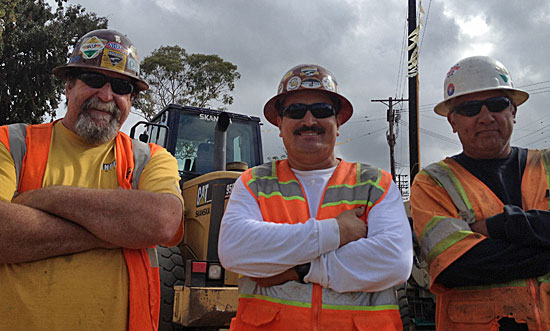
With 400 construction workers already building Expo Phase 2, a court-ordered stay would be devastating.
For more than a year, construction crews have been hard at work on the second leg of the Expo Line, building bridges that will separate trains from surface street traffic and laying the groundwork to extend the popular light rail line all the way to Santa Monica.
Some 400 construction workers are on the job today, along with more than 4,000 others whose work is directly or indirectly tied to the project.
But, with $300 million already spent on this urgently-needed $1.5 billion project, there’s an obstacle that’s suddenly threatening to stop Expo in its tracks.
While this light rail project enjoys widespread public support as an important transit alternative to the severely clogged 10 Freeway that runs alongside it, a small group in the neighborhood has been waging a long-running battle against Expo. Their arguments, challenging the project’s environmental review process, already have been rejected at the state trial and appellate court levels, and now are before the state Supreme Court.
I’m confident that the Expo Authority, which won at both the state trial and appellate court levels, will prevail again before the California Supreme Court. But in the interim, there’s a new and worrisome twist in the case: the challengers are asking the high court to issue a stay that would immediately shut down work on the project until the justices have decided the matter.
This week, I joined with other local officials in calling on the court to please keep the Expo project rolling forward without interruption.
Shutting down work at this juncture would be devastating on so many levels. Our recession-wracked region still has unemployment that’s way too high—and it’s even worse among construction workers.
Just ask Lawrence Douglas, a carpenter apprentice who just started working on Expo a month ago, after 14 months of looking for work. Or Tim White, a crane operator who’s also found work—but wonders whether the job will disappear abruptly in the next few weeks. Or Clementino Perez, a drilling supervisor who knows that each paycheck ripples out well beyond the individual who earns it: “We have a lot of people working over here, and if they shut us down, we’re going to be staying home. That affects the economics for all our families.”
And the impact doesn’t stop there. The county’s taxpayers, who are paying for the project with funds from the voter-approved Measure R, will see the tab go up by at least $90 million if there’s a court-ordered stop in construction. And the project would take at least a year longer to build—which is bad news for the tens of thousands who are looking forward to ditching their cars and riding the train each day. (Already, Expo’s first segment, from downtown Los Angeles to Culver City, is attracting 20,000 riders a day, and growing.)
Attorneys representing the Expo Line recently filed papers with the California Supreme Court strongly opposing the neighborhood group’s motion for a stay. I believe their arguments are extremely persuasive, and that the high court will see the importance of keeping this project moving forward even while the case as a whole is under review.
But I also think that this issue is too important to be left just to the lawyers. Everyone in Los Angeles has a stake in this project.
Let’s keep Expo on track to open all the way to Santa Monica by 2015, and please, let’s keep construction workers out of the unemployment lines and out on the front lines of building a better transit future for all of us.
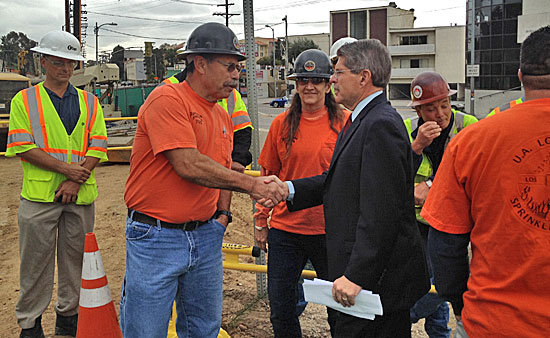
Supervisor Yaroslavsky greets workers this week at the future site of Expo's National/Palms station.
Posted 10/23/12




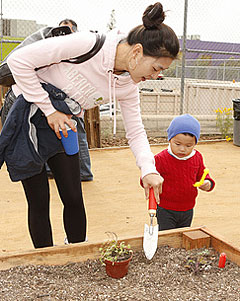
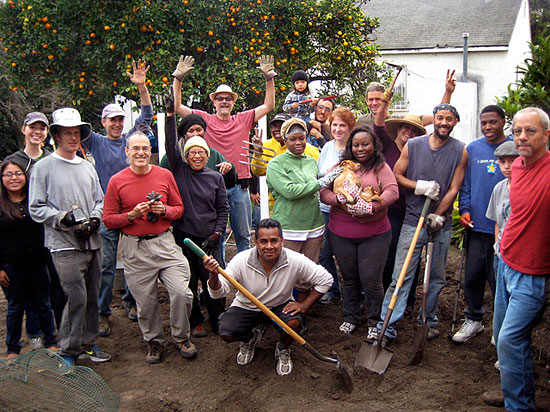
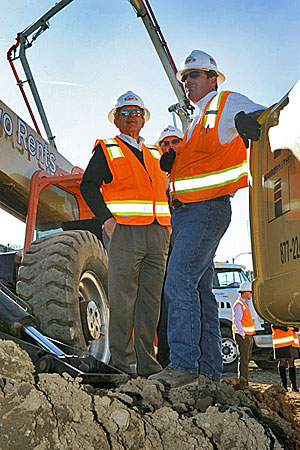
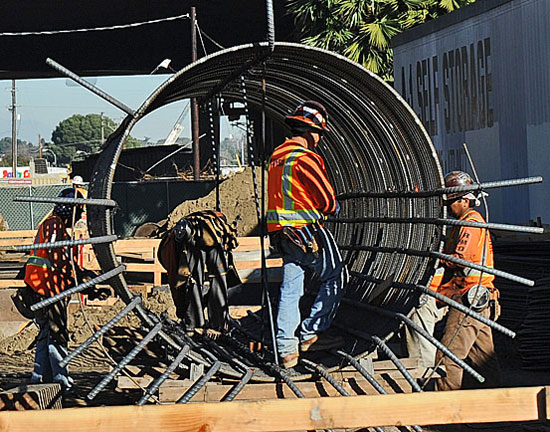
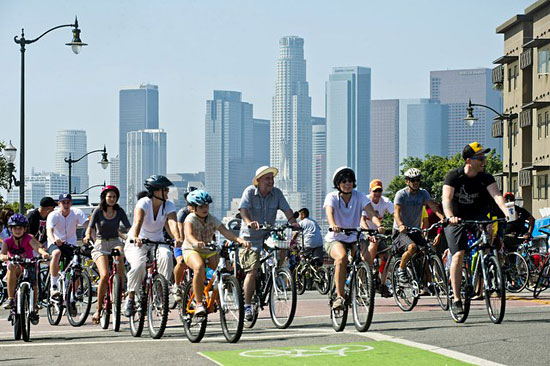

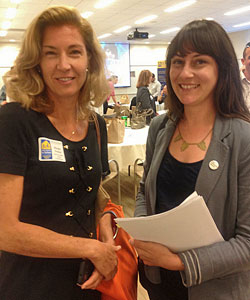
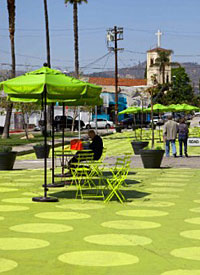
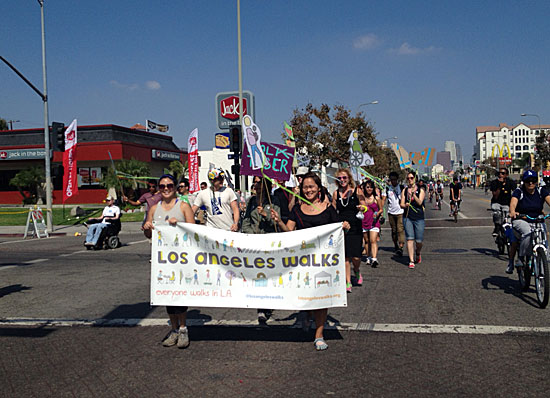
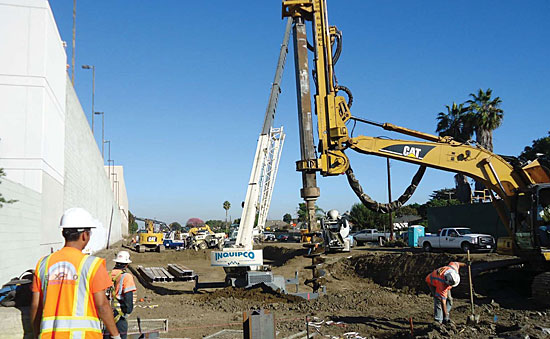







 405 bridge work causes a stink
405 bridge work causes a stink

